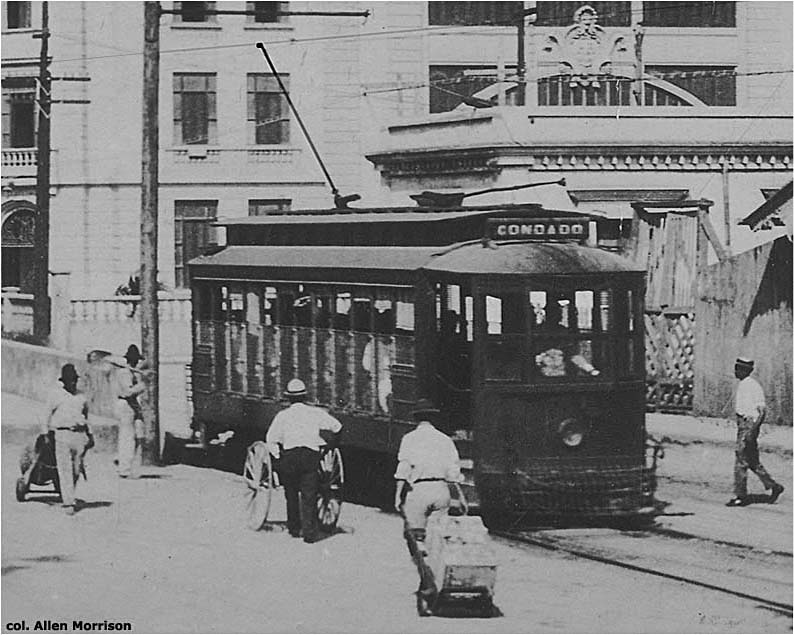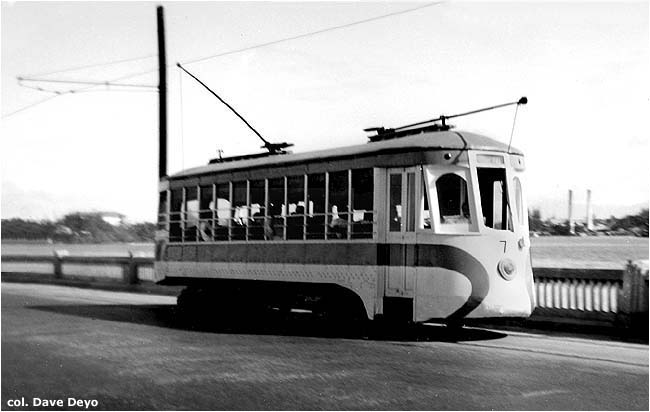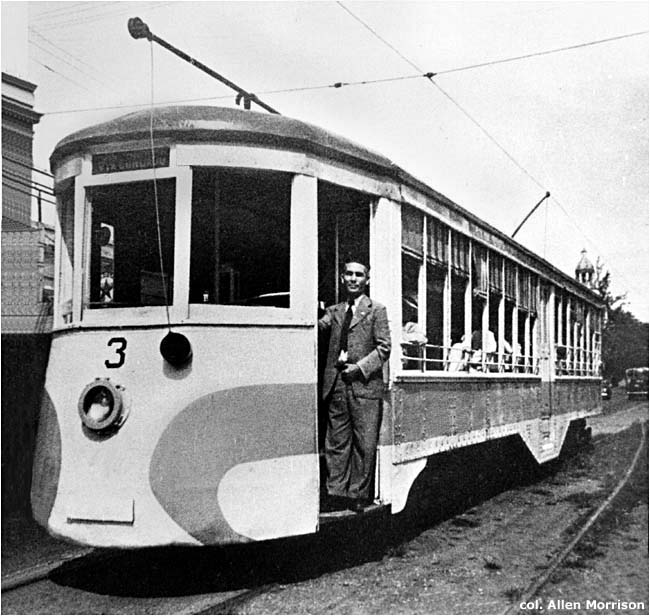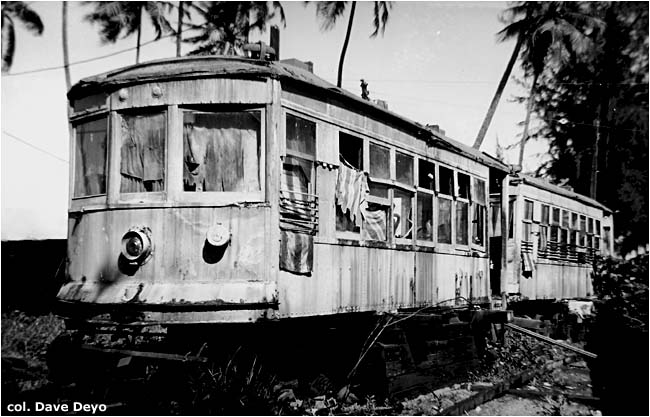The Tramways of
SAN JUAN
PUERTO RICO
BY
Allen Morrison
The island of Puerto Rico was one of four territories surrendered by Spain after the Spanish-American War of 1898. Cuba gained its independence, but Puerto Rico, Guam and the Philippines became possessions of the United States. The U.S. renamed the island Porto Rico – even though the word porto does not exist in Spanish! The correct spelling was officially restored in 1932. Puerto Rico's first railways were built under Spanish rule and generally used European equipment and track gauges. Its main line, the 300 mi/475 km Ferrocarriles de Puerto Rico, which opened in 1891 and circled the island, was built to meter gauge, which was unknown in North America and rare in the Caribbean. The new owners renamed it American Railroad and marked the locomotives "A.R.R." The first railway in the San Juan area was the 7 mi/12 km Tranvía (Tramway) de Ubarri. It opened in 1880, was powered by small steam locomotives, used 29.5 in/750 mm gauge and was later called Tranvía de la Capital. The line ran from Old San Juan along Av. Ponce de León to Río Piedras [see map]. The area's second railway was the 4 mi/7 km Línea Férrea del Oeste (Western Rail Line), which opened in 1883 and connected Cataño and Bayamón across the bay. It was operated by the Compañía Férrea del Oeste and used meter gauge. No suitable illustration of the Ubarri line – the Tranvía de la Capital – could be found. But here is an extremely rare, very old, never before published photograph of the Línea Férrea del Oeste. The picture was probably taken in the 1880s. The origin of the trams is unknown [col. Dave Deyo; reproduced with his permission]: |

The colorized postcard view below shows another Línea Férrea del Oeste train, this time on Calle del Tren (Train Street) in Cataño [see map]. It is believed that this scene typifies what both of the area's tranvías looked like in the last years of the 19th century. The locomotive was built in 1882 by Black, Hawthorn & Co. in England [col. AM]:
The two San Juan steam lines ran along wagon roads and were called tranvías (tramways), but could just as well have been called suburban railways. San Juan never had horsedrawn trams on its streets. In 1900 San Juan Light & Transit Co., registered in Canada, purchased the San Juan - Río Piedras steam line and ordered 17 double-truck, double-end (bi-directional) electric passenger trams from the United States: ten cars from American Car Co. in St. Louis, and seven from John Stephenson Co. in New York. Here is a picture of one of the American cars, which were numbered 1-10 [col. AM]:
J. G. White Engineering Co. of New York laid new 70-pound standard gauge track and strung overhead wire along Av. Ponce de León, exactly duplicating the steam line, from San Juan to Río Piedras [see map]. In the historic district called Old San Juan the electric cars looped through the narrow streets. San Juan Light & Transit inaugurated its new 8 mi/13 km electric line to Río Piedras on 1 January 1901 [Street Railway Journal, 23 IX 1905, p. 446: see BIBLIOGRAPHY]. Note flags:
The stops or paradas along the avenue were numbered, from 1 in Old San Juan to 40 in Río Piedras [see map]. The numbers became so identified with the locations that some street maps still show them today – 60 years after the trams disappeared! The following illustration appeared in the Street Railway Journal of 22 February 1908 [see BIBLIOGRAPHY]:
About 1903 SJL&T built a branch from stop/parada 23 north to a park that it built on the Atlantic Ocean [see map]. Trams going to Borinquen Park were signed "AL PARQUE" or "PARK". In 1906 San Juan Transit was absorbed by a new Canadian organization, Porto Rico Railways Co., which formed a subsidiary, Porto Rico Railway, Light & Power Co., to operate the tramway and other utilities. The Stephenson tram in the picture below shows its new owner [col. AM[:
Tram 4 in this photograph, taken on Calle San José in Old San Juan [see map], is apparently from the original American Car Co. fleet of 1900 [col. Joaquín Flores]:
In their first two decades of operation the electric trams traveled clockwise around the circuit in Old San Juan, as shown in this postcard view: the car extreme right is coming forward, traveling east on Calle San Francisco [see map]. After about 1915 and through the 1940s, however, trams followed a counterclockwise loop, went the other way [col. AM]: |

In 1907 Porto Rico Railways formed another subsidiary, Caguas Tramway, and hired J. G. White Engineering Co. to build a 17-mile/28-km extension of its electric line from Río Piedras to Caguas [see map]. It ordered eight passenger cars from J. G. Brill in Philadelphia, which it numbered 101-108 [Brill's Magazine, X 1907, p. 192: see BIBLIOGRAPHY]:
J. G. White graded the extension and began laying standard gauge track, but Caguas Tramway changed its mind and decided to build a meter-gauge steam line instead, in order to provide interchange with the meter-gauge American Railroad, which it intersected in Río Piedras [see map]. The rails were moved over. Overhead wires were never installed. The new Brill cars never ran to Caguas but were instead renumbered 18-25 and used in San Juan. PRRL&P's Río Piedras - Caguas steam railroad opened in 1908. Despite the name on the Brill cars, which has misled historians, the city of Caguas never had a tramway, nor did trams ever run between Río Piedras and Caguas. The steam railroad was never electrified and closed in 1928 [see below]. In 1910 Porto Rico RL&P placed an order with Brill for 10 quasi-open trams with screened sides and center aisles which were similar to cars that ran in summers in New York and other U.S. cities. They were numbered 26-35 and called "jaulas" (cages) by San Juan residents [Brill Magazine, V 1911, p. 141: see BIBLIOGRAPHY]:
Interior view [Brill Magazine, V 1911, p. 144: see BIBLIOGRAPHY]:
The jaula in this postcard view is descending the grade between Plaza Colón and Paseo de Covadonga, alongside Fort San Cristóbal, part of the ancient ramparts around Old San Juan [see map]. The tram is traveling outbound toward Borinquen Park [col. AM]:
In 1911 PRRL&P built a new line through Condado which connected with the Park line and formed a large loop [see map]. Track was single, but there were sidings on each leg of the loop so that trams could go around it in both directions. This new track completed the San Juan tramway system. It never expanded further. The entire network was, and always remained, single track with sidings. Cars ran in both directions on the single track, such as that shown below on the causeway that connected San Juan with Condado (in the distance). Tram 25, signed "CONDADO", is presumably a reconstruction of one of the "Caguas Tramway" cars shown above [col. AM]:
|


A line-up of trams headed west on Calle Recinto Sur in Old San Juan [see map]. Destination signs were the same on both ends of the cars. The third tram is signed "STOP 15". Fleet numbers and operator names were rarely visible on San Juan streetcars. Note that the schoolgirls are oblivious to the trams, but are very conscious of the photographer [postcard, col. AM]: |

The two trams shown on the postcard below are in the same spot on Calle Recinto Sur as those in the preceding view, but they are going the other way, toward the ARR station whose tower is visible in the distance [see map]. Until that station was completed, ARR trains terminated at the building on the right, which was originally the terminus of Ubarri's steam tramway. By 1917, when this picture was taken, all rails had disappeared from the yard beyond [col. AM] |

The Tranvía de Ubarri had been replaced by PRRL&P's electric line in 1901. But the area's other steam tramway, Línea Férrea del Oeste, which is shown in the first two pictures on this page, continued to operate with locomotives from Cataño to Bayamón across the bay [see map]. It added several gasoline-powered railcars to its fleet in the 1920s. Their builder is unknown [col. Dave Deyo]:
The trolley shown in the postcard view below has arrived at the end of Av. Ponce de León in Miramar and is turning north onto the approach to San Antonio bridge [see map]. Trams ran in both directions on this track [col. AM]:
In Santurce the line was on the south side of Av. Ponce de León [see map], so this view is west. The tram has just passed another car on the siding and is going toward Old San Juan [postcard, col. AM]
A passing siding on the private right-of-way section in Condado [see map]. The grass in the foreground nearly hides the other rail that will be used in a minute by the tram in the distance [postcard, col. AM]:
|

The intriguing view below was published in 1903, in the early days of operation – or perhaps before operation began, on the branch to Borinquen Park [see map]. The tram crew has gathered at the rear of the car, probably so that the sign could be included in the photograph. "Military Road" and "Carretera" were alternate names of Av. Ponce de León [col. AM]: |

The McGraw Electric Railway Directory of 1924 reported 35 electric passenger trams running on 14.5 mi/23.3 km of standard gauge track in San Juan. The cars numbered 1-10 were the Americans built in 1900, numbers 11-17 were the Stephensons of 1901, cars numbered 18-25 were the "Caguas" trams and 26-35 were the screened-in jaulas (the latter two groups built by Brill between 1907 and 1910). All vehicles were beginning to show their age. In 1926 PRRL&P began a program of modernization, reconstructed some of its old rolling stock, and ordered six large new double-truck, single-end, two-man steel trams from Perley A. Thomas Car Works in High Point, North Carolina. Each was 46 ft/14 m long, sat 65 passengers and had front and center doors on both sides for loading on both sides of narrow streets. The new trams arrived in March 1927, were numbered 37-42, and placed in service in April. The photograph below shows number 37 in Old San Juan [see map] [col. AM]: |
0
On 13 September 1928 San Juan was ravaged by Hurricane Okeechobee (called Huracán San Felipe in Puerto Rico), the only category 5 storm ever to hit the island. Because Puerto Rico had sufficient warning (thousands had perished in Guadalupe), there were relatively few fatalities in San Juan, but the Río Piedras tram line and depot were damaged beyond repair and were abandoned. The steam railway to Caguas and the Línea Férrea del Oeste, which ran from Cataño to Bayamón across the bay, also closed at that time. After September 1928 PRRL&P parked its trams in a yard at Borinquen Park and buses ran along Av. Ponce de León to Río Piedras [see map]. The new Perley Thomas cars had been spared, but many other trams were lost. The World Survey of Foreign Railways of 1933 [see BIBLIOGRAPHY] reported only 11 passenger trams in operation in San Juan – the six Perley Thomas cars and five older cars. The following two illustrations were copied from an album of photographs taken by an American professor who taught at University of Puerto Rico in 1937-1939. The Perley Thomas trams had a new paint scheme. Number 40 is crossing the trestle next to the San Antonio railroad bridge [Robert A. Hall]:
|

An inscription on the back of the picture below indicates that tram 41 was photographed on Calle Salvador Brau in Old San Juan in "1936 or 1939". That street is called Calle San Francisco today [see map]. The word "LAZO" (loop) in the car's destination window on the left means that the it is going to follow the big loop around Santurce; the barely legible words "vía Condado" in the middle window indicate that it will travel clockwise. The photographer did not write his name [col. AM]:
|

The next photograph, also taken in 1944, shows one of the five cars from the beginning of the century that had been remodeled and reconstructed single-end. Tram 7 is crossing the causeway between San Juan and Condado [see map], which was also shown in a postcard view above [col. Dave Deyo]:
The Water Resources Authority/Autoridad de Fuentes Fluviales ran the last tram in San Juan (and Puerto Rico) on Monday night 30 September 1946. (Actually, according to newspapers, the last car, Perley Thomas number 4, pulled into Borinquen yards at 0:45 am 1 October [see map].) A rich chapter in Puerto Rican transport history had come to an end. The photograph below, taken in 1947, after the system had closed, shows two of the four Birney trams that WRA/AFF had purchased in the United States in 1942, and which it planned to splice together to make two double-truck cars. Three of them, including the two shown here, came from the Third Avenue Railway in New York. The fourth, which came from the abandoned tramway in New Castle, Pennsylvania, was lengthened and rebuilt as a 4-axle tram. It was numbered 12 and ran for a short time in San Juan, but derailed frequently so was withdrawn. Nothing was ever done with the New York cars [col. Dave Deyo]:
The American Railroad ran its last train in Puerto Rico in 1957. Construction began forty years later, in 1997, on the first stage of a heavy-rail metro in San Juan, called Tren Urbano. The initial 10.5 mile line, between Sagrado Corazón station in Santurce and Bayamón, began free rides for the public in December 2004 and finally inaugurated full commercial operation on 6 June 2005. Most of the line is elevated, but has a mile of tunnel, with two underground stations, in Río Piedras.
BIBLIOGRAPHY "Tranvía Eléctrico" in La Correspondencia de Puerto Rico (San Juan), 4 February 1901. A short article announces the operation of the first electric tram in the city – but doesn't indicate the date. "Electric Railways" in Electrical Review (New York), 16 February 1901, p. 233. A news item announces the inauguration of San Juan's "new trolley system" on 1 January 1901. "The Electric Railway at San Juan, Porto Rico" in Street Railway Journal (New York), 23 September 1905, pp. 446-448. Good, long article about the new electric tramway. Six illustrations, including a view of a horsecar in Mayagüez (incorrectly identified). "Brill Semi-Convertible Cars for Porto Rico" in Brill's Magazine (Philadelphia), October 1907, pp. 192-195. Nice article about the eight trams that J. G. Brill built for the "Caguas Tramway Company". Good description of the vehicles and also of the line under construction between Río Piedras and Caguas. Five pictures. "Baggage Car with Steel Underframe for Porto Rico" in Brill's Magazine (Philadelphia), February 1908, pp. 41-44. Long article about construction of the Caguas line and the rolling stock built for it. Four pictures. "Trolley and Power Developments in Porto Rico" in Street Railway Journal (New York), 22 February 1908, pp. 274-277. Construction of the San Juan tramway, the Caguas extension and the dam and power plant at Comerio Falls. Map and 10 photographs. "Brill cars for Steam Railway Service in Porto Rico" in Brill's Magazine (Philadelphia), August 1908, pp. 185-187. Description and picture of passenger car 106 built for the Caguas railway. "Interesting Cars for Porto Rico" in Brill Magazine (Philadelphia), May 1911, pp. 141-145. Description and four illustrations of the jaulas (screened cars) shown on this webpage. McGraw Electric Railway Directory (New York), 1918 and 1924 editions consulted. Corporate data, technical descriptions, inventory of rolling stock, track length, etc., of the San Juan tramway. "Tranvía de San Juan" in Informe del Comisionado del Interior al Gobernador de Puerto Rico, 1919. San Juan, 1919. Nice system history, from steam through the early electric days. Eugenio Fernández y García. El Libro de Puerto Rico/The Book of Porto Rico. San Juan, 1923. Photograph of the gasoline-powered car of the Línea Férrea del Oeste on p. 703 of the English-language edition. "Porto Rico Railway Gets Six New Two-Man Cars" in Electric Railway Journal (New York), 23 April 1927, p. 761. Specifications, drawing and two photographs of new Perley Thomas vehicles. "Revenue Doubled by Modernization of Porto Rico Railway" in Electric Railway Journal (New York), 31 December 1927, pp. 1193-1195. Acquisition of new Perley Thomas cars, reconstruction of old cars. System map (!) and four excellent large photographs. United States. Bureau of Foreign & Domestic Commerce. World Survey of Foreign Railways: Supplement #50. Washington, 1938. Supplement to the original 1933 survey reports 19 standard gauge vehicles for the electric line: 11 passenger cars, 5 tank cars (?), 1 locomotive, 1 work car and 1 line car; and 91 meter gauge vehicles for the steam line, including 2 locomotives and 18 passenger cars. [Anonymous, untitled article] in ERA Headlights (Hoboken, NJ), August 1946, p. 3. Track map and history of the San Juan Santurce Street Railway. Article states that "all of the street cars are second hand", which is untrue, but otherwise provides a nice description of the system's last days. The author was unaware how very few remained. "Un ruidoso pasaje llegó hasta la última parada" in El Mundo (San Juan), 2 October 1946, p. 7. Feature article on the end of tramway service in San Juan. Large photographs. Adolfo de Hostos. Historia de San Juan, Ciudad Murada. San Juan, 1966. This 590-page history has chapters on "El Tranvía de Ubarri", pp. 89-92; and "El Tranvía de Cataño a Bayamón", pp. 149-150. Latter chapter doesn't say when the line closed. Emilio E. Huyke. Historia de la Transportación en Puerto Rico. San Juan, 1973. The chapter on "El Tranvía" provides a nice general history of tramways on the island, with emphasis on San Juan. Oscar L. Bunker. Historia de Caguas. Caguas, 1981. The plan to extend the Río Piedras electric tramway to Caguas was abandoned and a steam-powered railway was built instead, Tomo II, pp. 229-230. Robert A. Hall. Trolley-Car Memories, 1915-1960. Ithaca (NY), 1982. Professor Hall's recollections, photographs and maps from his residence in San Juan between 1937 and 1939. Two of his snapshots appear on this webpage "Clang Clang Clang Went the Trolley: The Ultimate Trolley" in San Juan Star, Sunday Magazine (San Juan), 24 July 1983. Memories and testimonies from old motormen and conductors about streetcar operation in San Juan. Aníbal Sepúlveda Rivera. San Juan: Historia ilustrada de su desarrollo urbano, 1508-1898. San Juan, 1989. Impressive, large format, 336-page survey of the city's development during its first 400 years. Hundreds of photographs and diagrams. Drawings of Ubarri's tramway terminal on pp. 210-211. Maps showing railways on pp. 238-239, 314-315 and 332-335. Unfortunately, there are no pictures of trains or trams. Florencio Sáez. Río Piedras: estampas de mi pueblo, 1898-1945. San Juan, 1996. Chapters entitled "El Trolley", "Ruta del Trolley" and "Estación del Trolley", pp. 44-46, provide detailed information about the city's first electric line. Moody's Manuals (New York). Annual editions provide historical background, information on finances, data on rolling stock, system length, etc., of the various tramway companies that existed in San Juan in the early 20th century. Archivo Histórico y Fotográfico de Puerto Rico - Colección Rodríguez / Historical Ephemera and Photographic Images of Puerto Rico from the Rodríguez Archives Collection. Extraordinary assemblage of historic material, photographs, postcards and other documents, indexed and cross-indexed by subject and locale. Highly recommended. –––––––––––––––––––– In addition to the authors and photographers noted above, the author would like to thank Dave Deyo of Somerset, Massachusetts, for the valuable information and illustrations that he provided. They have greatly enriched this page.
See also and
If you have comments, criticism or suggestions, This site was placed online on Copyright © 2008-2108 Allen Morrison |




















